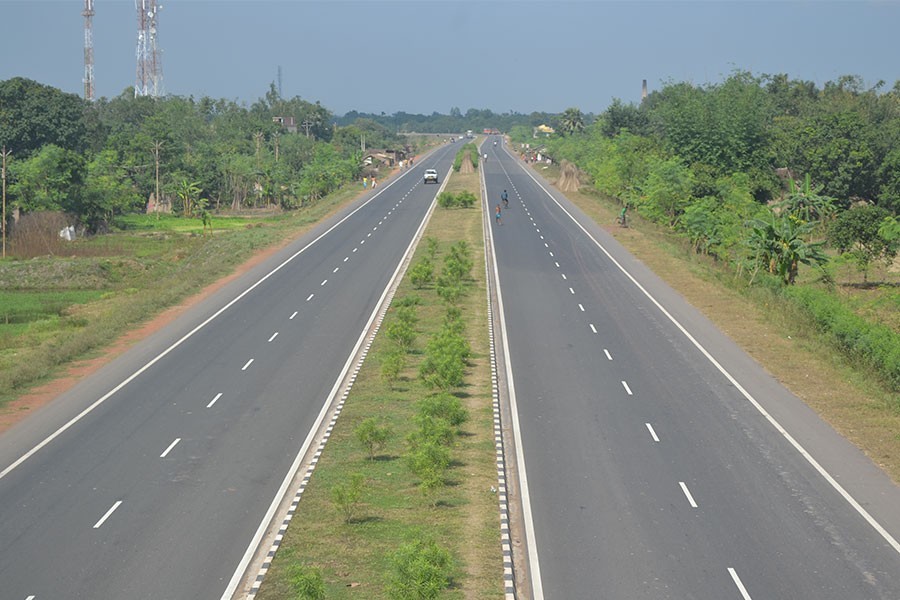Focus on fully access-controlled highways for speedy, safe traffic
Expressway in BD yet a far cry

Published :
Updated :

The country is yet to have an expressway for fast moving traffic though transport experts consider such infrastructure to be a 'milestone' of economic development.
Experts said the focus of Roads and Highways Department (RHD) is more on development of highways, mainly to turn the two-lane ones to four-, six- or eight-lane ones.
But the RHD is yet to make any of these highways an access-controlled one or expressway, which is necessary to ensure safe, speedy and uninterrupted movement of all kinds of vehicles, they noted.
"The infrastructure is now considered to be the safest ensuring optimum productivity," said Professor Shamsul Hoque of Civil Engineering Department of Bangladesh University of Engineering and Technology (BUET).
According to the RHD, the construction of Dhaka-Mawa highway has been planned with the features of an expressway by incorporating intersection solution uprooting signalling system as well as lane separation from locality for ensuring movement of vehicles at high speed.
Dhaka-Mawa is the only highway on which construction is going on to turn it into an expressway.
Sources said the 57-kilometre highway is being gradually turned into an expressway, raising the project cost by more than 70 per cent.
The project's original cost was Tk 62.52 billion that has increased to Tk 105.43 billion as changes have been made to its entire design.
"There was lack of concept among the road planners and designers, for which new projects could not be planned with fully access-control facility," said an engineer concerned.
The RHD now has more than four four-lane projects, planned with service roads and ensuring connectivity with areas on both sides of the arteries.
But none of these is fully access-controlled, as many-intersection solution is not possible for them due to lack of wide open space, he added.
The lone expressway, envisioned by the RHD on Dhaka-Chittagong corridor, is still in the planning stage after more than five years of work.
According to the RHD, its planning on access-controlled highway faced problem in the middle of the planning due to lack of policy on expressway.
RHD's Dhaka-Chittagong expressway project lagged behind the schedule.
The Bangladesh Bridge Authority (BBA) has also planned to construct the expressway as an entirely-elevated one with high-speed train facility on the same corridor blocking progress of the RHD project since 2015.
The RHD project resumed in 2017 following the high-ups' decision in this regard.
The BBA is entitled to construct bridges over 1.5 kilometres, and three expressways have been planned for the elevated road. But it could start construction of one project six to seven years after the contract was signed.
Construction of Dhaka Elevated Expressway began in 2016 under public-private partnership (PPP) initiative, although the contract with the project's private partner was signed in 2011.
According to the experts, an expressway separates the traffic from zilla roads, regional roads and highways for uninterrupted traffic.
It also ensures partial access in some important locations on the corridor.
They also said neighbouring countries - India, Sri Lanka and Pakistan - have already developed 21, 03 and 11 expressways respectively as a solution to speedy transportation of goods and passenger vehicles.
Business communities have long been demanding congestion-free roads and highways, as gridlock causes waste of huge time to carry their export-import goods and related items to and from industrial zones and ports.
The government has taken various measures to improve the traffic situation.
But still it takes eight hours on an average to cross more than 200 kilometres on Dhaka-Chittagong Highway to use Chittagong Port.
Meanwhile, the government has taken a move to prepare a master-plan on expressway to construct access-control highways in the country.
The government focuses on construction of the high-cost expressways through PPP.
The BUET professor said the master-plan is needed to protect lands and spaces along and adjacent to a corridor for intersection solution.
He said 40 to 50 acres of land is needed for intersection solution, which is must for uninterrupted movement of vehicles.
smunima@yahoo.com


 For all latest news, follow The Financial Express Google News channel.
For all latest news, follow The Financial Express Google News channel.